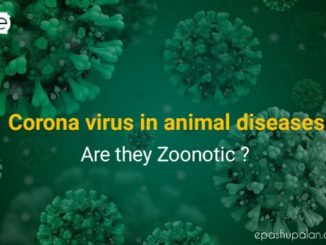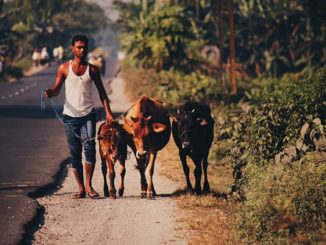If oestrus has not been observed in a dairy cow by 60 days post partum the condition is defined as Post Partum Anoestrus (PPA). In other terms, anestrous is the lack of expression of estrus signs or absence of estrus. ‘Postpartum anestrous is most common problem in dairy herds, it is defined as the interval from parturition to the day on which first estrous is expressed by animals. Consequences of prolonged postpartum anestrous are an increase in days open, calving interval, services per conception and decrease in fertility and pregnancy rate that leads to major economic losses.

Management of Postpartum anestrous
Management plays a important role for prevention of postpartum anestrous in dairy cows. The following mangemental factors that prevent postpartum anestrous.
Nutritional management
- Nutritional intervention during prepartum and postpartum period is one of the major input to improve reproductive problems. Provide balanced ration to the animal in last trimester of pregnancy.
- Prepartum and postpartum dry matter intake should be optimum.
- Maintain energy intake to minimize negative energy balance.
- Supplementation of bypass fat
- Maintain adequate rumen degradable and undergradable protein (RDP &RUP) ratio in ration.
- Supplementation of minerals & vitamins
-Phosphorus- 10 to15 gm per day (10-15 d)
-Selenium- 5 mg + 50 IU of vitamin E (Inj) / 50 kg body weight
-Vitamin A- Shark liver oil- 200 IU / kg body weight
-Vitamin E- Germinated germ oil- ½ to 1 kg (10-20 d)
-Supplementation of feed additives (ionophore) improves feed efficiency and coccidiosis control. - Provide green forage to the animal throughout the year
- Provide glucogenic precurson. Drenching of propylene glycol during early lactation period increase the concentration of glucose and insulin.
Management of postpartum diseases
The following management intervention will help to reduce postpartum disease.
- Examination of the reproductive tract during the period of 3 to 7 weeks after parturition
- Minimize exposure to infection
- Frequent observation
- Clean paddock
- Clean, disinfect and remove the bedding material from maternity pens after each calving.
- Do not use maternity pen for one to two months
- Use clean, disinfected instruments during assistance at calving time
- Avoid undue stress
- Maintain adequate reproductive record
- Ad libitum green fodder must be provided at least 4 to 5 weeks postpartum
- Female with report of abnormal discharge should be examined and treated
- Examine retained placenta cases and treat within 3 days
- Provide assistance during difficult calving
- Reduce dystocia related injuries
- Treatment of postpartum debilitating deseases like metritis and cystic ovary
Biostimulation
Biostimulation by teaser bull or androgen treated cows decreses postpartum interval to estrus and improve pregnancy rate in Bos indiucus and Bos taurus. But the mechanism is still not clear. The stimulatory effect not solely depends on the bull as similar results were found by exposing the anestrus cows to androgen treated cows. Olfactory and auditory signals as well as nuzzling, nudging and licking of the perineal region of female are possible mechanism of biostimulation and may induse the estrous behavior. Androgen in urine acts as pheromones. Biostimulation can be used as effective managemental tool for late-calving cows before 60 days postpartum as it has no effect after that. In case of suckling cows it is effective after 35 day. Cows should be exposed to bulls for a minimum 12 hours period as intermittent exposure has little or no effect. Fence-line contact is also effective.
Heat detection
The single most important factor that limits the establishment of pregnancy, survival and detection of anestrous related problems in dairy cattle and buffaloes and thereby reproductive efficiency of a gerd is estrus detection efficiency and accuracy. More commonly, animal are diagnosed to be in estrus based on the appearance of mucus discharge, mounting or standing to be mounted and other physical activities. Proper estrus detection is the biggest bottleneck in achieving high conception rate with artificial insemination in dairy animal. Various management factors contribute to failures in diagnosis of estrus. Besides, that concentration of the estrogenic substance present in plants or fodders varies according to different seasons of the year, short duration estrus behavior in lactating cows, poor estrus behavior when housed on concrete flooring, as well as duration and intensity of light to which the animal are exposed also influence the onset of estrous cycle. Thus, the estrus detection efficiency and accuracy are the most important parameters for improving both the individual animal as well as overall herd fertility. Several tools ranging from visual appraisal to sensor based automated instruments have been developed and employed for estrus detection in dairy animals but have shown varied success rate. The use of specific estrus detection aid depends upon the scale of operation, availability of man power, type of animals etc. but, a single aid cannot always be used everywhere. Attempts at automatic electronic detection of pheromones associated with heat have begun with some promises. Similarly, heat detection with activity meter has also been tried with limited success. However, wireless sensor and voice recognition technology has given some promises for non invasive accurate heat detection. Recent developments in proteomics and biotechnological tools are also expected to help in identification of biomarkers for efficient and accurate heat detection.
Other managemental practices
The following various managemental strategies will help to overcome the problem of postpartum anestrous.
- Divide large groups in herd to small groups for better management.
- Early weaning should be practiced to remove the suckling effect. Removal of calf for short period (48 hrs) is also effective to induce estrous.
- Decrease milking frequency in anestrous cows.
- Reduce postpartum anestrous by selection of genotype and individual animals.
- Early assistance should be provided to the animal in time of need during calving difficulty.
- Rectal palpation should be done after 30 days postpartum to examine the condition of follicle and corpus luteum in the ovary.
- Body condition score can be used as effective managemental tool to determine the energy store of the animal. Animals with moderate body condition score resume ovarian activity early as they utilize additional energy for pregnancy, lactation and resumption of estrus, whereas in case of fatty animals unnecessary energy reserves go waste. On the other hand, animals with low BCS have basic energy store to carry out growth, activity and basal metabolism only. BCS of 3.25 to 3.5 should be maintained at calving.
Conclusions
Anestrous is the major factor in dairy cows regulating reproductive efficiency. Proper management interventions have prime importance in induction of estrus in anestrous cows for maintaining high reproductive efficiency. Anestrous can be prevented by providing required energy through balanced ration and maintenance of optimum BCS during calving. Further, examination of reproductive tract during post partum can identify the type of anestrous. Hormonal treatment along with effective estrus synchronization protocol may reduce the occurrence of prolonged anestrous condition. In organized dairy herd, increase in efficiency of estrus in cows. In addition, weaning practices and maintenance of proper record will be helpful for reduction in days to first post-partum ovulation.
|
The content of the articles are accurate and true to the best of the author’s knowledge. It is not meant to substitute for diagnosis, prognosis, treatment, prescription, or formal and individualized advice from a veterinary medical professional. Animals exhibiting signs and symptoms of distress should be seen by a veterinarian immediately. |






2 Trackbacks / Pingbacks